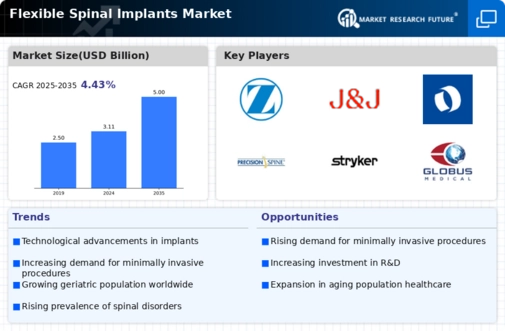Rising Incidence of Spinal Disorders
The increasing prevalence of spinal disorders, such as degenerative disc disease and spinal stenosis, is a primary driver for the Flexible Spinal Implants Market. As populations age, the incidence of these conditions rises, leading to a greater demand for effective treatment options. According to recent data, spinal disorders affect millions worldwide, prompting healthcare providers to seek innovative solutions. Flexible spinal implants offer a promising alternative to traditional surgical methods, providing enhanced mobility and reduced recovery times. This trend is likely to continue, as advancements in implant technology improve patient outcomes and satisfaction. Consequently, the growing patient population suffering from spinal issues is expected to significantly boost the Flexible Spinal Implants Market in the coming years.
Technological Innovations in Implant Design
Technological advancements in the design and materials used for flexible spinal implants are propelling the Flexible Spinal Implants Market forward. Innovations such as bioresorbable materials and 3D printing techniques are enhancing the functionality and adaptability of these implants. For instance, the introduction of implants that mimic the natural biomechanics of the spine has shown promising results in clinical trials, leading to improved patient outcomes. Furthermore, the integration of smart technologies, such as sensors that monitor implant performance, is gaining traction. These developments not only improve the efficacy of spinal surgeries but also reduce the risk of complications, thereby increasing the attractiveness of flexible spinal implants to both surgeons and patients. As these technologies continue to evolve, they are likely to drive further growth in the Flexible Spinal Implants Market.
Rising Awareness and Education on Spinal Health
The growing awareness and education regarding spinal health are driving the Flexible Spinal Implants Market. Public health campaigns and educational initiatives are informing individuals about the importance of spinal care and the available treatment options for spinal disorders. As awareness increases, more patients are seeking medical advice and treatment for their spinal issues, leading to a higher demand for flexible spinal implants. Additionally, healthcare professionals are becoming more knowledgeable about the benefits of these implants, which encourages their use in clinical practice. This heightened awareness is likely to result in an increase in the number of spinal surgeries performed, thereby boosting the Flexible Spinal Implants Market. As educational efforts continue, the market is expected to expand further.
Growing Preference for Minimally Invasive Surgery
The shift towards minimally invasive surgical techniques is significantly influencing the Flexible Spinal Implants Market. Patients and healthcare providers alike are increasingly favoring procedures that minimize tissue damage and reduce recovery times. Flexible spinal implants are particularly well-suited for these types of surgeries, as they can be inserted through smaller incisions, leading to less postoperative pain and quicker rehabilitation. Market data indicates that minimally invasive spinal surgeries are projected to grow at a compound annual growth rate (CAGR) of over 10% in the next few years. This trend is expected to drive demand for flexible spinal implants, as they align with the goals of modern surgical practices. As more surgeons adopt these techniques, the Flexible Spinal Implants Market is likely to experience substantial growth.
Increasing Investment in Healthcare Infrastructure
The expansion of healthcare infrastructure, particularly in emerging economies, is a crucial driver for the Flexible Spinal Implants Market. Governments and private entities are investing heavily in healthcare facilities, aiming to improve access to advanced medical technologies. This investment is leading to the establishment of specialized spinal surgery centers equipped with the latest surgical tools and implants. As a result, the availability of flexible spinal implants is increasing, making them more accessible to patients. Furthermore, enhanced healthcare infrastructure is likely to facilitate training programs for surgeons, promoting the adoption of innovative surgical techniques. This trend is expected to create a favorable environment for the growth of the Flexible Spinal Implants Market, as more patients seek effective treatments for spinal disorders.


















Leave a Comment